- Home
- Sebastian Junger
Fire Page 19
Fire Read online
Page 19
The Tadić case was the first successful prosecution of a war crime by the ICTY. It has indicted ninety people for crimes committed in the former Yugoslavia and has an unknown number of secret indictments. Thirty of the accused are now in custody, including ten Bosnian Croats who surrendered in 1997 and three Bosnian Serbs who surrendered in 1998. One was killed resisting arrest. On July 25, 1995, South African Judge Richard Goldstone, acting as the tribunal’s chief prosecutor, indicted Bosnian Serb President Radovan Karadžić and his chief of staff, General Ratko Mladić, with genocide, war crimes, and crimes against humanity. Four years later, neither one has been caught; Mladić is said to spend his days on a Bosnian Serb military base, tending beehives and a herd of goats. Each goat has been named after a Western leader or UN commander.
Considering the time and effort that it takes to indict someone for war crimes, the question of whether the investigations serve a purpose—in the absence of arrests—is a hard one to avoid. Judge Goldstone, who now heads an independent commission on NATO’s use of force in Kosovo, is adamant that they do. “To turn people for the rest of their lives into international pariahs is not something that any rational person would like,” he says. “Karadžić was no longer able to continue in office and had to disappear from the international scene…. The quality of their life is diminished considerably…. One is looking over one’s shoulder every day of one’s life.”
Slobodan Milošević, as president of Yugoslavia, is not looking over his shoulder in quite the same way, but his is a precarious existence nonetheless. There is widespread discontent in the army, the country’s infrastructure and economy are in ruins, and Montenegro wants to abolish the Yugoslav Federation. Because of the international arrest warrants, Milošević cannot flee to another country, and the United States is withholding economic aid to Serbia until he has been removed from power. “It is in the interest of the peoples of Serbia that [he] be transferred to The Hague,” maintains David Scheffer, United States ambassador-at-large for war crimes issues. “It will remain a very difficult proposition to bring Serbia into the international community and into, frankly, the New Europe if Serbia remains a de facto sanctuary for indicted war criminals…. We think the odds are with us.”
Because of the turmoil in Yugoslavia, there is a good chance that Milošević will one day stand trial. (Indeed, he has reportedly started making inquiries about hiring an English lawyer.) He has already been charged with crimes against humanity and violations of the laws and customs of war and may be charged with genocide as well, the most serious breach of humanitarian law. To convict him, the ICTY would have to show that he intended to destroy, “in whole or in part,” the Albanian population of Kosovo. The fact that his forces generally spared women and children does not disqualify him from charges of genocide; theoretically, even one murder could be considered genocide if there was intent to harm the rest of the group. By that standard, the policies of the Milošević government easily qualify.
The atrocities in Kosovo are so well documented that Milošević will probably not bother to challenge them in court; instead, he may try to claim that he was unaware they were happening. He may already have had an eye toward that kind of defense when he encouraged paramilitary and militia forces to carry out many of the actual massacres in Kosovo. NATO has been eavesdropping on Serbian forces in the field since the beginning of the air war, though, and that will make an ignorance defense difficult. “To prove chain of command, we are relying to a great extent on intelligence agencies in the Western countries,” says Landale, spokesman for the ICTY. “They are obliged to give it to us. We will try to show knowledge of crimes and failure to prevent them or to punish them.”
When one hears accounts of the massacres in Kosovo, one is struck by both their terrible efficiency and their even more terrible savagery. Many of those responsible were hastily deputized militiamen who, to judge by the sheer creativity they showed in killing people, must have been quite intoxicated by their sudden power. They shot people one by one, and they mowed them down in groups; they burned them alive, and they cut their throats; they tortured them, and they just walked up and shot them in the backs of the heads. They briefly wielded absolute power in their brutal little lives and must have never stopped to think that they might one day be held accountable for it.
THE TERROR OF SIERRA LEONE
2000
The sin of Judah is written with a pen of iron, and with the point of a diamond.
—JEREMIAH 17:1
Josephus, the son of an up-country diamond trader, checked over his shoulder and pulled a pack of 555-brand cigarettes out of his pocket. He opened the top and shook two diamonds into his palm, a twenty-five-carat coffee-colored industrial and a three-carat white gem. They looked like rock candy. We were at the Cape Sierra Hotel, one of the few safe places in Freetown, and Josephus wanted to do business.
“How do I know they’re real?” I asked.
Josephus picked up a beer glass and dragged a long scratch down the side with the white. Very few things are hard enough to scratch glass, and a diamond is one of them. Josephus said that his father was a local chief in Kono and had large mining concessions there. Kono, a district in the northeastern corner of the country, is the richest diamond-producing area in Sierra Leone and—not coincidentally—is still under rebel control. Every two weeks, Josephus said, he flew to Freetown to sell diamonds and returned with rice and palm oil for the miners. The miners were paid a dollar a day, and if they found any stones, they got a commission.
I could sense the bartender watching us. Josephus slid the stones back into their hiding place and said he could get more if I was interested. I told him I had to think about it. I was in Sierra Leone to write about the diamond trade, but being taken for an investor was virtually unavoidable. No one believed for a second that my photographer, Teun Voeten, and I were just journalists; Sierra Leone has been run as a mining scheme for the last seventy years, and there was no reason we should see it any differently. Before we arrived, a London contact had set up a meeting for us with one of the most powerful men in the Sierra Leonean military. Not for an interview, which he never would have consented to, but for a diamond deal.
Of all days for business, though, this was a bad one. Word had just gotten out that UN peacekeepers had surrounded Foday Sankoh’s house in retaliation for rebel attacks elsewhere in the country. Sankoh is head of the RUF—the Revolutionary United Front—as the rebels call themselves, and under the UN-sanctioned Lomé Peace Accord of July 1999 he was given a government position and a compound outside Freetown. The day before, his forces in the field—possibly without consulting him—had encircled a UN disarmament camp in the town of Makeni and demanded that the Kenyan peacekeepers turn over ten rebels who had voluntarily surrendered their weapons. The commander refused, shooting broke out, and seven UN personnel were taken prisoner. The rest were still surrounded.
The last time Sankoh was arrested, the government had sentenced him to death. In response, the RUF nearly overran Freetown.
I told Josephus I’d look him up in a few days, and then I paid the tab and walked out of the hotel. The sudden thick dusk of the tropics had just dropped, and I could see garbage fires winking on the hillside above town. I dodged the crowd of hookers in front of the hotel and got into a hired car and told the driver to take me to Sankoh’s house. The driver hesitated and then said he’d have to double his usual rate. We drove out across Aberdeen Bridge and through the roadside markets and shantytowns of Lumley, on the outskirts. Sankoh’s compound was on a hill overlooking town; it consisted of an ugly yellow villa with a wall around it and a gutted concrete structure that served as a bunker. We pulled up to a flimsy checkpoint in the driveway, and a single UN peacekeeper stepped forward and asked us what we wanted. There were no other peacekeeping troops, no white-painted UN vehicles; the place was deserted. Suddenly a dozen young toughs in street clothes came running out of the bunker.
“Who are you? What do you want?” they shouted, pu
shing the peacekeeper aside. I explained that I was a journalist and had come to talk to Sankoh, but that was clearly not the right answer. They screamed that he wasn’t in, and one of them started pounding on the roof of the car.
“Turn around,” I told the driver. “Get us out of here.”
The driver threw a fast U-turn, and we raced back the way we came. Halfway down the hill we pulled over to make way for a convoy of pickup trucks filled with more of Sankoh’s boys. They weren’t armed, but they were singing and pumping their fists in the air, as if they knew something.
As it turned out, they did.
The RUF started quietly and brutally when a hundred or so lightly armed guerrillas crossed into Sierra Leone from war-torn Liberia in late March 1991. Their intent was to overthrow the one-party system of Joseph Saidu Momoh, but the force included a large number of mercenaries from Liberia and Burkina Faso, and the campaign quickly devolved into an excuse to loot and kill. Playing off traditional male initiation rites, the rebels abducted children and teenagers, took them into the bush, and tattooed them with identifying marks so that they couldn’t return to society unnoticed.
The rebels’ leader, Foday Saybana Sankoh, was a Sierra Leone Army corporal who had been jailed for seven years for his suspected involvement in a 1971 plot to overthrow the government. After getting out of prison, he set up a photography business in Kailahun District, on the Liberian border, and spent the next decade traveling around the diamond fields of eastern Sierra Leone. At first Sankoh claimed simply to want to rid the country of one-party rule, but his forces quickly distinguished themselves with a brutality that was exceptional even by the standards of African warfare. Their trademark was amputations, mostly of hands, as a tactic to terrorize the local population. It was one of the only uses of mass amputations in the history of warfare, and it gave the RUF, a small, poorly armed force that had no real backing, a power disproportionate to its size.
Announcing their attacks beforehand to inspire terror, the rebels swept through southern and eastern Sierra Leone in a matter of months. The national army was too small, too disorganized, and too corrupt to offer much resistance. Some of them even joined forces with the rebels to loot. By 1995 the rebels were on the outskirts of Freetown, and President Valentine Strasser, a twenty-nine-year-old army officer who himself had seized power three years earlier, hired the South African security firm Executive Outcomes to deal with the problem. Making great use of several MI-24 helicopter gunships, Executive Outcomes took only a matter of weeks to drive the rebels out of Freetown and then out of Kono—although they neglected to destroy every last rebel base. (That would later prove to have been a mistake.) The gunships reportedly were so effective that the rebels offered a seventy-five-thousand-dollar reward—payable in diamonds—to anyone who destroyed one.
Utterly beholden to Executive Outcomes, the country was reported to have given up huge mining concessions in the face of a bill equal to half its annual defense budget. (Executive Outcomes denied having received concessions.) By January 1996 Strasser had been replaced by Julius Maada Bio, who in turn was replaced by the current president, Ahmad Tejan Kabbah, in a democratic election. In many other countries this would have been the end of the story, but not in Sierra Leone. Disgruntled army officers who hadn’t been paid in months ousted Kabbah in 1997, released six hundred inmates from Pademba Road Prison, brought the rebels into the government, and instituted their own brutal regime. They, in turn, were thrown out by ECOMOG, a Nigerian-led regional peacekeeping force that managed to reinstate Kabbah as president in early 1998. Kabbah, however, then made the mistake of executing twenty-four disloyal army officers and bringing Sankoh up on charges of treason. The charges stemmed from a 1997 arms-buying trip Sankoh had made to Nigeria on behalf of the RUF. The rebel leader was quickly found guilty, but before his death sentence could be carried out, a sketchy alliance of rebels and army irregulars staged another attack on Freetown.
War does not get much worse than January 6, 1999. Teenage soldiers, out of their minds on drugs, rounded up entire neighborhoods and machine-gunned them or burned them alive in their houses. They tracked down anyone whom they deemed to be an enemy—journalists, Nigerians, doctors who treated wounded civilians—and tortured and killed them. They killed people who refused to give them money, or people who didn’t give enough money, or people who looked at them wrong. They raped women and killed nuns and abducted priests and drugged children to turn them into fighters. They favored Tupac T-shirts and fancy haircuts and spoke Krio—the common language of Freetown—to one another because they didn’t share a tribal language. Some were mercenaries from Liberia and Burkina Faso, a few were white men thought to be from Ukraine, but most were just from the bush. They had been fighting since they were eight or nine, some of them, and sported such names as Colonel Bloodshed, Commander Cut Hands, Superman, Mr. Die, and Captain Backblast. They fought their way west in Freetown, neighborhood by neighborhood, through Calaba Town and Wellington and Kissy, and they weren’t stopped until they had nearly overrun the ECOMOG headquarters at Wilberforce Barracks.
Eventually the Nigerian-led military machine set itself in motion. It attacked with heavy artillery and Alpha jets and helicopter gunships. Some of the gunships were piloted by white South Africans who just threw mortars out of the gun bays when they ran out of ammunition. Slowly the rebels fell back. Realizing that they were going to lose the city, they started rounding up people and detaining them until special amputation squads could arrive. The squads were made up of teenagers and even children, many of whom wore bandages where incisions had been made to pack cocaine under their skin. They did their work with rusty machetes and axes and seemed to choose their victims completely at random. “You, you, and you,” they would say, picking people out of a line. There were stories of hands’ being taken away in blood-soaked grain bags. There were stories of hands’ being hung in trees. There were stories of hands’ being eaten.
“They marched us at gunpoint to the hill near Kissy Mental,” one fifteen-year-old girl named Ramatu later told human rights investigators. “They didn’t say why they were taking us but we knew…. They had us get down on our knees and put our arms on a concrete slab…. One rebel did all the cutting. A few had both hands cut off; others just one. And then they walked away. I couldn’t even bury my arm.”
It took several weeks, but the Nigerians eventually drove the rebels out of Freetown and back up-country. Six thousand people had died in Freetown. Although the rebel assault had failed militarily, it had so traumatized the civilian population that it was prepared to do almost anything—including accept the rebels as part of the government—in order to bring an end to the war. The result was the Lomé Peace Accord, which granted a blanket amnesty to all combatants, instituted a nationwide disarmament program, opened the door to eleven thousand UN peacekeepers, and assigned government posts to rebel commanders. Sankoh was made vice-president of the country, as well as chairman of the Commission for the Management of Strategic Resources, National Reconstruction and Development.
That was a lot of words to say that he was now the diamond czar of Sierra Leone.
Everyone’s fear—that the UN would surround Sankoh’s house and arrest him—turned out to be unfounded, but the night I’d driven up there, the mood in the city was as tight as a piano wire. By dark the streets were empty, and around midnight bursts of automatic gunfire were heard in the hills outside Freetown. It turned out to be just skittish security forces shooting at one another. There were rumored to be thousands of RUF within the city itself, waiting for the signal to rise up, and no one knew when that moment would come. Teun and I were supposed to travel to the diamond fields up-country, and we were worried that if things got any worse, the planes would stop flying and we’d be stuck in Freetown. A contingent of rogue soldiers known as the Westside Boys had blocked the only road out of the city, and the UN was on the verge of suspending all internal flights because of the deteriorating security situation up-country. If Teun and I
were going anywhere, we had to do it in a hurry.
The next morning we drove to a bullet-peppered airfield outside town and boarded an old twin prop that flew us up Bunce River and over the Moyamba Hills to the diamond-trading town of Bo, two hundred miles to the east. The first thing we did on the ground was check in with the commander of the Kamajors, a civil defense force made up of tribal hunters from the eastern part of the country. The Kamajors were wild fighters who terrified everybody, including the people they were defending, and until recently they had gone into battle wearing marine life jackets for effect. The Kamajors were supposed to be immune to bullets, and the rebels were so intimidated by Kamajor magic that in a sense it worked.
The commander assured us that God would take care of whatever the UN couldn’t, which we took to mean that the Kamajors were busy rearming themselves, and then we wandered through town to talk to the diamond traders. Most of them had Lebanese names—Mansour, Jamil, Ahmad—and their offices were in small, brightly lit rooms tucked behind stores that sold radios and tools and dry goods and cloth—almost anything you’d want if you didn’t want diamonds.

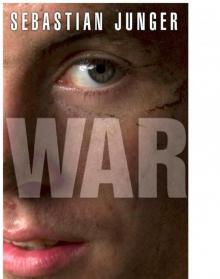 War
War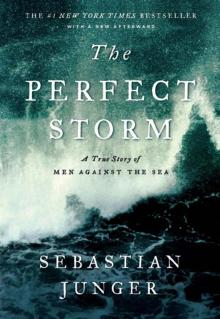 The Perfect Storm: A True Story of Men Against the Sea
The Perfect Storm: A True Story of Men Against the Sea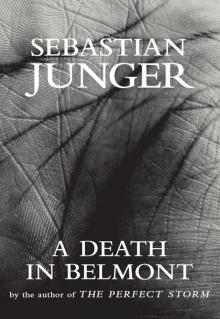 A Death in Belmont
A Death in Belmont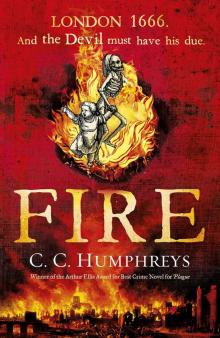 Fire
Fire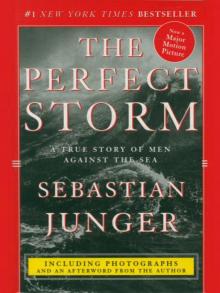 The Perfect Storm
The Perfect Storm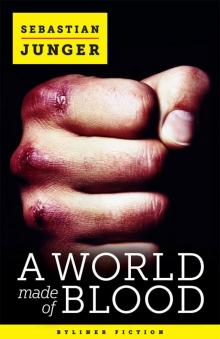 A World Made of Blood (Kindle Single)
A World Made of Blood (Kindle Single)